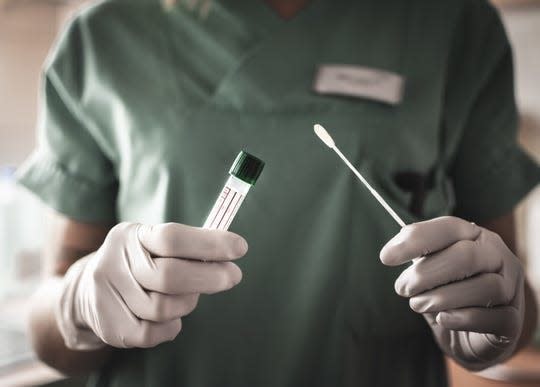IU Health Bloomington hospital lost $45 million in 2022. Here's why

High labor costs, especially for contract nurses, dragged down IU Health Bloomington Hospital’s financial performance, causing the nonprofit facility to incur a loss for the first time in more than a decade.
The hospital reported a loss of $45 million in 2022, according to IRS records. The documents were filed late last year and are the most recent available.
Losses are rare for the hospital. The hospital last posted a loss in 2008, of $6.6 million. Since then, the hospital has been in the black every year, generating a total profit of nearly $900 million.
The hospital’s tax records show revenue in the last few years has increased annually — but not enough to keep up with rising expenses, especially related to drugs and labor.
“We simply have a lot of individuals who retired early after the strain of the pandemic,” said Brian Tabor, president of the Indiana Hospital Association.
Hospitals have been scrambling to hire and retain respiratory therapists, radiation technologists and especially nurses, he said, though that’s not an Indiana-specific problem.
Some of those workers are returning, Tabor said, but even in combination with new graduates, they are not returning in high enough numbers to offset retirements and the rising number of aging Americans who need care.
Bruce Wade, IU Health South Central Region vice president of human resources, said via email, "Retirement numbers have increased rapidly in this field, while many nursing school capacities haven’t followed suite as quickly as needed to fill the vacancies.
Wages, contract labor costs pushing up Indiana hospital expenses
At IU Health Bloomington, salaries and wages for employees jumped from $109 million in 2018 to nearly $300 million in 2022 — though the health system also has grown significantly since then. It employed about 2,700 in 2018 but more than 4,500 in 2022. The average compensation per employee went from just under $40,000 in 2018 to nearly $65,000 in 2022. That’s an average annual increase of 16% — excluding benefits.

Compensation for officers, directors, trustees and key employees during that same stretch increased by an annual average 13%. The reported compensation for Brian Shockney, the health system’s senior vice president for regional operations, in the last three years has averaged around $1.1 million.
According to IRS records, the Bloomington hospital in 2022 also incurred expenses of nearly $44 million in contract labor, reflecting health systems’ increasing reliance on so-called travel nurses and doctors. Contract labor costs accounted for 10% of the hospitals’ total expenses that year.
Comparisons with prior years are difficult as IU Health Bloomington did not report expenses for contract labor in prior reports.
IU Health did not mention contract labor in its most recent system-wide audited financial statement. The IU Health system generated a profit of $121 million from its health care operations in 2022. However, it incurred an overall loss because of investment losses of nearly $700 million. IU Health Bloomington's investment income fell by 87% from 2021 to 2022, but remained positive, at about $1.6 million.
Rare loss: IU Health lost money in 2022 — for first time in more than a decade. Here's why
Tabor said medical staffing shortages are prompting hospitals everywhere to hire more contract employees, which is pushing up labor costs.
For example, the Columbus hospital said in its most recent report, “The increases to operating expenses are largely driven by industry and macroeconomic factors, including highly competitive labor markets, inflationary pressures on general purchasing, including for supplies and most notably, contract labor and other contract services.”
While expenses for contract labor are moderating somewhat, Tabor said contract nurses in the not-too-distant past could cost hospitals two or three times as much as a full-time nurse.
The American Hospital Association said in a news release, "The hours worked by travel nurses as a percentage of total hours worked by nurses in hospitals grew from less than 4% in January 2019 to over 23% in January 2022," but the association also suggested staffing agencies that were supplying the travel nurses were "exploiting workforce shortages by inflating prices to increase their own profit margins throughout the pandemic."

Tabor said health providers are trying to address the labor issues. For example, IU Health in early 2022 announced it would grant $8.75 million to Ivy Tech Community College “to help expand enrollment of nursing students and address Indiana’s critical shortage of nurses.”
Tabor said the demand for contract labor has diminished since its peak, but remains — and likely will remain — higher than the historical average. Hospitals can expect a greater share of their employees than normal will be contract labor, whereas hospitals formerly relied on contract workers only for seasonal surges or emergencies such as a pandemic.
While some other hospitals in the IU Health system also posted losses — the hospital in Portland lost $1.7 million, the Lafayette hospital lost $6.6 million — many others posted profits:
The Carmel hospital generated a profit of $109 million in 2022, up 4% from the prior year. Revenue increased 10%, while expenses rose 16%.
The Muncie hospital reported a profit of $25 million in 2022, though that was down from $72 million the year before. Revenue rose less than 1%, and expenses rose by nearly 11%.
The Bedford hospital reported profit of $15 million in 2022, though that was down from $29 million the year before. Revenue fell by about 5%, while expenses jumped by 12%.
The Martinsville hospital incurred a loss of $268,000, though that was smaller than the losses the hospital usually reports. The Martinsville hospital last reported a profit in 2013, according to IRS records.
Indiana hospitals seeing higher costs for medical supplies, drugs

The Bloomington hospital also has seen sharp increases in costs for drugs and medical supplies. The facility in 2022 spent $108 million in that category, up an annual average 17% since 2018.
Tabor said when people read about drug prices going up, that affects health care providers as well as consumers. Many hospitals have to keep certain drugs on hand for critical needs, even if the drugs are never used. When prices for those drugs increase, running a hospital gets more expensive.
The IU Health Bloomington hospital also has spent more for employee benefits — up 24% on average in the last four years — insurance — up 40% annually — and advertising — up 94% annually — but those items combined accounted for only 5% of total expenses. Meanwhile, wages, supplies, drugs and contract labor accounted for about 60% of the hospital’s expenses in 2022.
Tabor said a smaller expense item that’s flying a bit under the radar, but which has been rising rapidly, is cyber security insurance. Hospitals increasingly have been targeted by cyber attacks that threaten the security of patient information, can interrupt services and prevent the hospital from sending bills to insurance companies. That interruption of cash flow can be devastating, especially for small, independent hospitals, he said.
Boris Ladwig can be reached at bladwig@heraldt.com.
This article originally appeared on The Herald-Times: IU Health Bloomington hospital reports $45M loss for 2022

